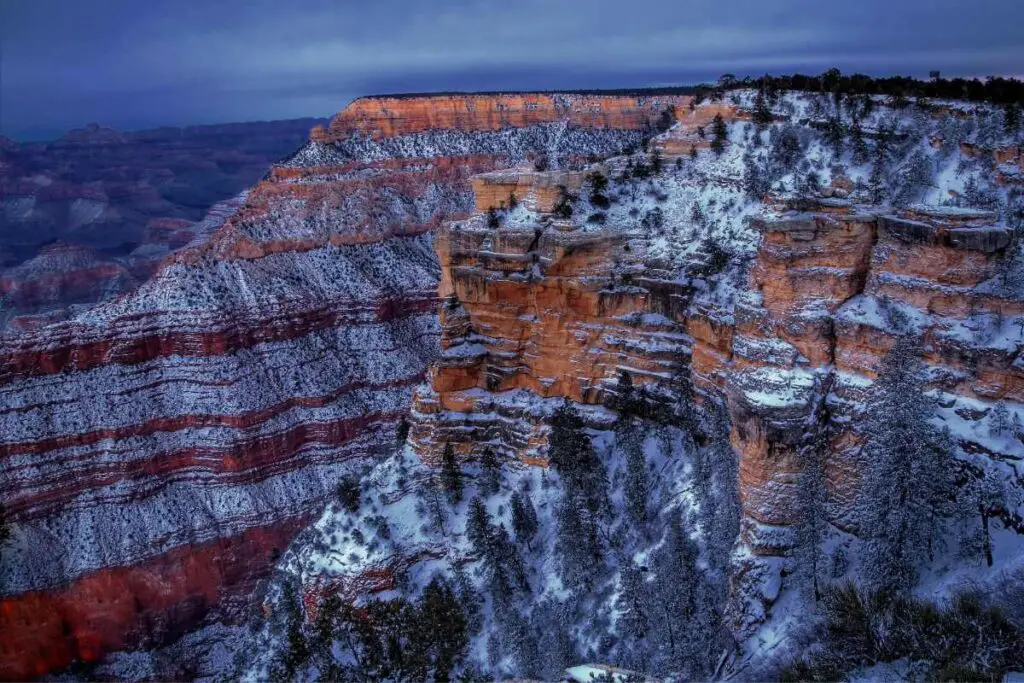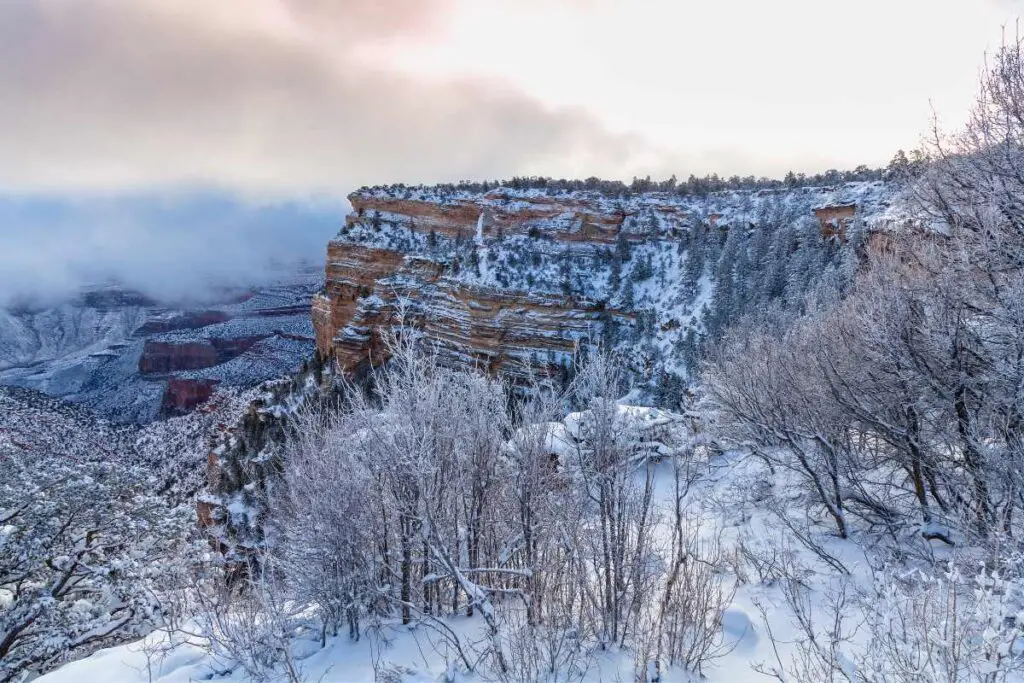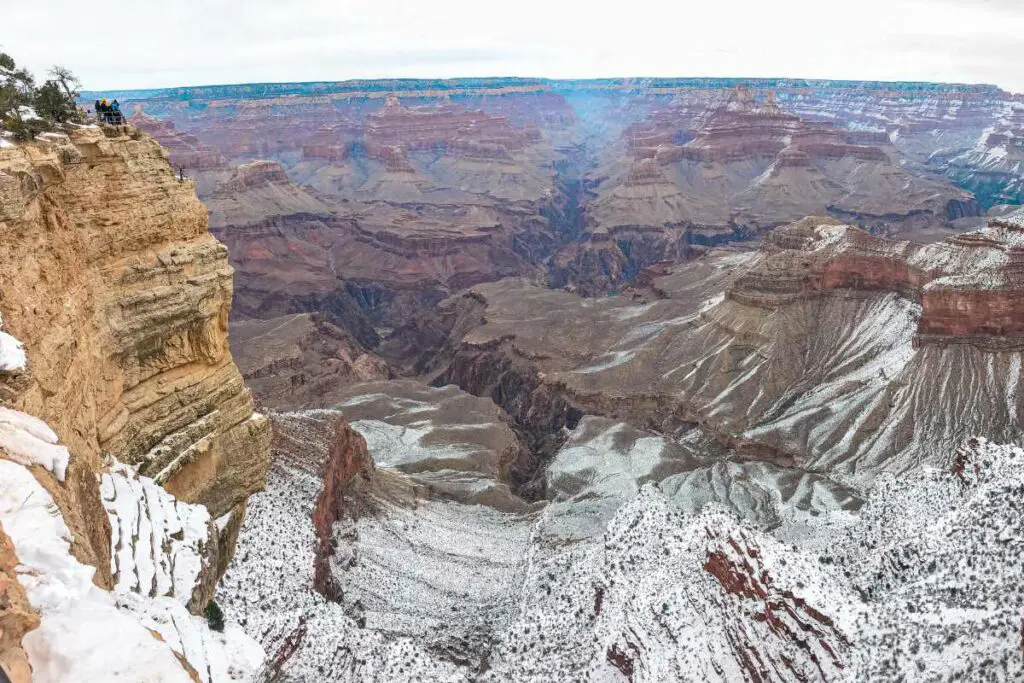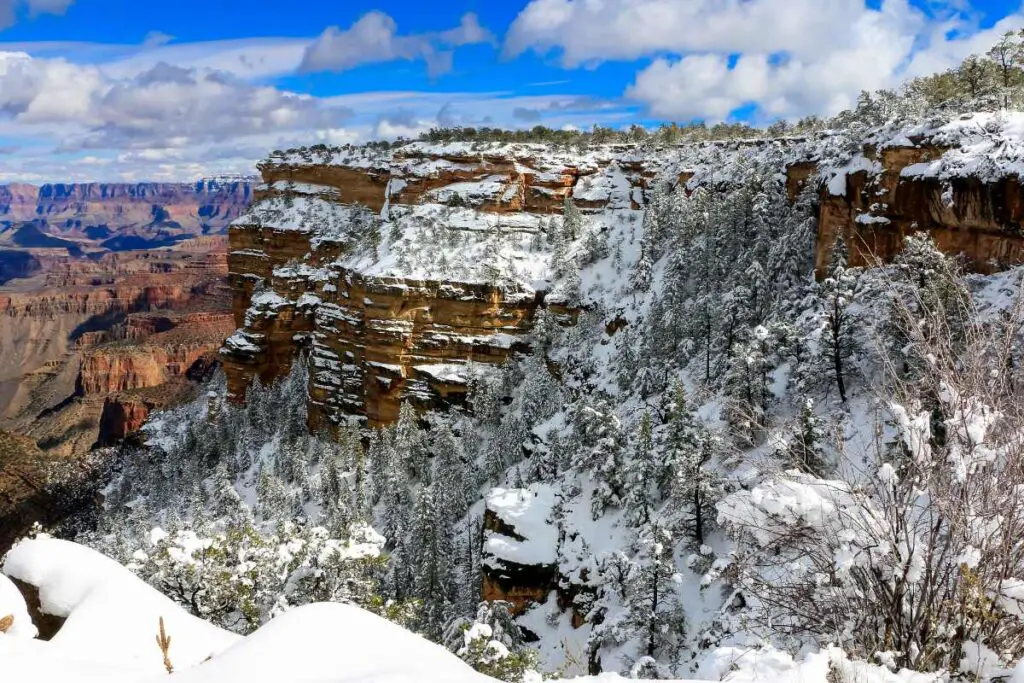If you’re looking for a unique and challenging winter adventure, hiking in the Grand Canyon might be just what you need.
While many people think of the Grand Canyon as a summer destination, winter can be a great time to visit the park. The crowds are smaller, the temperatures are cooler, and the scenery is just as stunning as ever.
While winter hiking in the Grand Canyon can be a rewarding experience, it’s important to be prepared. The weather can be unpredictable, and the trails can be icy and slippery.

It’s important to bring warm clothing, sturdy hiking boots, and plenty of food and water. It’s also a good idea to check with the park rangers for trail conditions and weather updates before you set out on your hike.
There are a variety of hiking trails to choose from in the Grand Canyon, ranging from easy strolls along the rim to challenging multi-day backpacking trips.
Some of the most popular winter hikes include:
- the Rim Trail
- the South Kaibab Trail
- the Bright Angel Trail
No matter which trail you choose, you’re sure to be rewarded with breathtaking views of the canyon and the surrounding landscape.
Weather and Climate
The Grand Canyon is a unique place with a varied climate that can change quickly.

The weather in the winter can be unpredictable, with temperatures ranging from below freezing at night to the 50s during the day.
Snow and ice can also be present on the trails, making hiking more challenging. It’s important to check the weather forecast before heading out and to come prepared with appropriate clothing and gear.
The South Rim of the Grand Canyon is generally more accessible in the winter than the North Rim, which is closed during the winter months. The South Rim sees less snow and milder temperatures, making it a popular destination for winter hiking. However, it’s important to note that the inner canyon can be significantly colder than the rim, so hikers should be prepared for a range of temperatures.
It’s also important to be aware of the limited daylight hours during the winter months.
The days are shorter, so hikers should plan their hikes accordingly and be prepared for hiking in the dark. Additionally, the National Park Service recommends checking road conditions and being prepared for potential closures due to winter weather.
Read next – Hiking Rim to Rim Grand Canyon
Overall, winter hiking in the Grand Canyon can be a rewarding experience, but it’s important to be prepared for the unique challenges that come with the season. With the right gear, planning, and knowledge, hikers can safely explore the beauty of the Grand Canyon in the winter.
Preparation and Gear
Winter hiking in the Grand Canyon requires careful preparation and the right gear to ensure a safe and enjoyable experience.

Here are some essential items to consider.
Apparel
- Warm, moisture-wicking base layers
- Insulating mid-layers (fleece, down, or synthetic)
- Waterproof and windproof outer layers
- Warm hat, gloves, and scarf or neck gaiter
- Sturdy, waterproof hiking boots with good traction
Equipment
- Backpack with a rain cover
- Tent with guylines and repair sleeve
- Tent footprint (optional)
- Sleeping bag rated for 0°F or lower, or suited to the season
- Sleeping pad for insulation and comfort
- Headlamp or flashlight with extra batteries
- Water bottles or hydration system with insulated hose
- Water filter or purification tablets
- Map and compass or GPS device with extra batteries
- Emergency whistle, signal mirror, and fire starter
- First aid kit with extra medication and supplies
Food and Water
It’s important to stay hydrated and well-fed during winter hikes, as your body uses more energy to stay warm.
Bring plenty of high-energy snacks and meals, such as nuts, dried fruit, granola bars, and instant soup. Plan to drink at least 2 liters of water per day, and consider bringing a thermos of hot tea or cocoa for a warm pick-me-up.
Remember that services can be limited in the park during the winter, so come prepared with extra food and water, as well as a windshield scraper and fluid, blankets, and other emergency supplies.
Trails and Routes

Winter hiking in the Grand Canyon can be a unique and rewarding experience, but it’s important to choose the right trail for your skill level and experience.
Here are some of the most popular trails and routes.
Bright Angel Trail
The Bright Angel Trail is one of the most popular trails in the Grand Canyon, and for good reason. It offers stunning views of the canyon and is well-maintained year-round.
However, it’s important to note that the trail can be icy and snowy in the winter, especially in the upper sections. Hikers should be prepared with proper gear and should consider turning back if conditions become too dangerous.
South Kaibab Trail
The South Kaibab Trail is another popular trail in the Grand Canyon, offering stunning views of the canyon and unique rock formations.

This trail is also well-maintained year-round, but can be more challenging than the Bright Angel Trail due to its steeper incline. Hikers should be prepared for a strenuous hike, especially in the winter when snow and ice can make the trail more difficult.
Hermit Trail
The Hermit Trail is a less-traveled trail in the Grand Canyon, but offers stunning views and a more secluded hiking experience.
This trail can be more difficult to navigate in the winter due to snow and ice, and hikers should be prepared for a more rugged and challenging hike. However, for experienced hikers looking for a unique and rewarding winter hiking experience, the Hermit Trail can be a great option.
North Kaibab Trail
The North Kaibab Trail is the only trail in the Grand Canyon that descends all the way to the Colorado River.
This trail is more remote and less-traveled than some of the other popular trails, but offers stunning views and a unique hiking experience. However, hikers should be prepared for a more challenging hike, especially in the winter when snow and ice can make the trail more difficult.
When choosing a trail for winter hiking in the Grand Canyon, it’s important to consider your skill level, experience, and the current weather and trail conditions.
Always be prepared with proper gear and supplies, and consider turning back if conditions become too dangerous. With the right preparation and precautions, winter hiking in the Grand Canyon can be a truly unforgettable experience.
Safety Tips
Winter hiking in the Grand Canyon can be a beautiful and rewarding experience, but it’s important to take precautions to ensure your safety.

Here are some tips to keep in mind:
- Check the weather forecast before you go and be prepared for cold, rain, wind, and snow. Dress in layers, wear a warm hat and gloves, and bring a waterproof jacket.
- Bring plenty of water and snacks to keep your energy levels up. Don’t rely on finding water along the trail, as many water sources may be frozen or dry during the winter months.
- Wear sturdy, comfortable hiking shoes with good traction. The trails and walkways may be icy, so consider using traction devices such as microspikes or crampons.
- Plan your route ahead of time and let someone know where you are going and when you plan to return. Stick to established trails and avoid steep or unstable terrain.
- Consider joining a guided hiking or backpacking tour with an experienced guide who knows the area and can help you navigate the trails safely.
Remember that the Grand Canyon is a remote and rugged wilderness area, and emergency services may be limited or unavailable during the winter months.
Always err on the side of caution and turn back if conditions become too challenging or dangerous.
Read this – Winter hiking mistakes you can avoid
Conclusion
Winter hiking in the Grand Canyon can be a unique and rewarding experience for those who are prepared for the challenges that come with it. The weather can be unpredictable, so it is important to check the forecast before heading out and to dress in layers.
It is also important to choose a trail that matches your skill level and to let someone know where you are going and when you plan to return. Be prepared for icy and snowy conditions on the trails and bring appropriate gear such as crampons or snowshoes.
While winter hiking in the Grand Canyon can be more challenging than hiking in other seasons, it also offers unique rewards such as fewer crowds and stunning winter landscapes. With the right preparation and precautions, winter hiking in the Grand Canyon can be a memorable and enjoyable experience.





